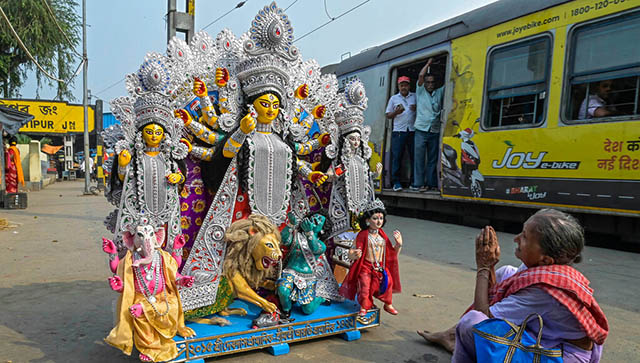It is that time of the year, Navaratri. Since the word “ratri” is feminine in Sanskrit, I prefer to say Navaratri, not Navaratra. Navaratri means nine nights. Shukla paksha (when the moon waxes) is for worshipping gods, krishna paksha (the fortnight when the moon wanes) is for worshipping ancestors. Of the twelve shukla paksha Navaratris in the year, four are more important – Ashada (June/July), Sharada or Ashvina (September/October), Magha (January/February) and Vasanta or Chaitra (March/April). Devi’s worship is associated with both Sharada Navaratri and Chaitra Navaratri. Most people know that. They may not be aware that Devi is also worshipped during Ashada and Magha Navaratri, but that worship is gupta or hidden, not performed in public view. We are approaching Sharada Navaratri and this is celebrated in different ways in different parts. If we are interested in rites associated with Devi’s worship in Sharada Navaratri, we should read Devi Bhagavata Purana, especially the third skandha. King Janamejaya asks Vedavyasa, “When Navaratri arrives, please tell me what is to be done? What are the rites? What are the fruits? Please tell me, with a focus on Sharada Navaratri.” Accordingly, Vedavyasa spells out _vratas (vows), _mantra_s, _yantra_s and the kalasha, the pot or the pitcher. A kalasha is important in all our puja_s. It is said that Vishnu resides in the mouth of a kalasha, Rudra in its neck and Brahma in its base. The story of Rama worshipping Devi at the time of Sharada Navaratri comes from Devi Bhagavatma Purana and Kalika Purana. It isn’t a story that finds a mention in any of the Sanskrit Ramayanas, including Valmiki Ramayana. If I am going to read Devi’s account, I should pick Markandeya Purana, Devi Bhagavata Purana and Kalika Purana. Stories about Mahishasura and Shumbha and Nishumbha are from Markandeya Purana, as are many of the _mantra_s used in Devi’s worship. There is a famous stotram known as Mahishasura-Mardini stotram, probably more commonly-known as Ayi Giri-Nandini stotram. Without knowing these stories, many allusions in the stotram will be missed. What bothers me is that we are increasingly forgetting these accounts, even if we celebrate Navaratri. Let me give an example from Shakti Peethas. Most people know the story of Daksha’s sacrifice and Shakti Peethas, where parts of Devi’s body fell. How many Shakti Peethas are there and where are they? That’s tough to answer. Depending on the text, I have names for 4, 18, 51 and 108. There is a stotram about 18 Shakti Peethas, attributed to Adi Shankaracharya. I recently watched an OTT series titled, “Sarvam Shakthi Mayam”. It is partly a documentary and is about an atheist who decides to visit 18 Shakti Peethas mentioned in Adi Shankaracharya’s stotram. In the process, the lives of the entire family change. Sometimes, geographical identification of a place mentioned in a strotram is obvious, such as Kamakshi in the city of Kanchika. There can be no dispute about where this is. But what is Shrinkhala Devi in Pradyumna? This is believed to be in Pandua, in Hooghly in West Bengal. This is where Sati’s stomach fell. However, if you go there and hunt for the Shrinkhala Devi temple, as the family in the OTT series did, you will be frustrated. That temple has been under lock and key, barred to public, for years, since there is a minaret there. If you go to Pandua and ask for Shrinkhala Devi temple, most local residents won’t be able to tell you. We have conveniently forgotten there was ever a temple there. In eastern parts, especially in West Bengal, Sharada Navaratri is associated with Durga Puja. In 2021, UNESCO added Kolkata’s Durga Puja to the list of the world’s intangible heritage. Historically, there have been three types of Durga Pujas: (1) those conducted by noble and aristocratic families (some were zamindars); (2) those in _matha_s or _mandir_s, and (3) community-driven. Over time, (1) and (2) declined in importance and (3) has taken over. Therefore, the younger generation may not even know that (1) and (2) ever existed. For instance, one of the most famous of (1) was that from Tahirpur, associated with the name of Raja Kansa Narayan. Tahirpur is in Bangladesh now. It is unrealistic to expect Bangladesh will publicise the first Durga Puja, in the present form, undertaken in Tahirpur in 17th century. (Some other _zamindar_s followed suit.) But we have forgotten about Tahirpur in West Bengal too. The most famous of (2), which still continues, is that in Belur Math. If you ask any young Bengali, you will be told that Durga Puja is from Saptami (seventh tithi) to Navami (ninth tithi), with concluding rituals on Dashami (tenth tithi). That’s indeed the homogenised and standardised format followed under (3), but not for (1) and (2). In the 16th century, Raghunandan Bhattacharya wrote some manuals, including one titled Durga Puja Tattva. Swami Vivekananda followed this in starting the Durga Puja in Belur Math. _Mantra_s may be from Markandeya Purana, but iconography evolved through Raghunandan Bhattacharya and subsequent work. A fierce Mahishasura-Mardini came to assume a family in iconography. Most people don’t know all this. The author is the chairman of the Prime Minister’s Economic Council and a well-known Sanskrit scholar. Views expressed in the above piece are personal and solely that of the author. They do not necessarily reflect Firstpost’s views. Read all the Latest News , Trending News , Cricket News , Bollywood News , India News and Entertainment News here. Follow us on Facebook , Twitter and Instagram .
Navaratri and Durga Puja: Festivity amid collective amnesia
Bibek Debroy
• October 17, 2023, 15:13:40 IST
We are increasingly forgetting the meaning behind Devi’s account in Puranas and other ancient texts, even if we celebrate Navaratri
Advertisement
)
End of Article